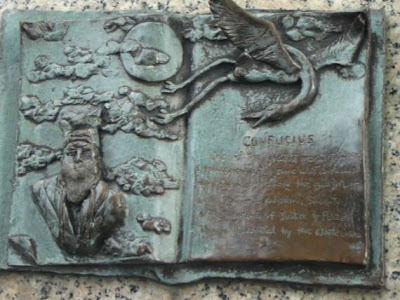 |
| Image of the Cathedral of St. John the Divine and the Peace Fountain courtesy of Gesalbte/Wikipedia. |
The Cathedral of St. John the Divine in New York City is the largest cathedral in the world. (St. Peter's Basilica in Rome is not a cathedral, although it is larger.) Begun in 1892, it is only two-thirds complete.
 |
| Image courtesy of Kevin Tsui. |
 |
| Image courtesy of Kevin Tsui. |
The sculpture, called The Peace Fountain, is a depiction of the struggle between good and evil, shown here as the struggle between the Archangel Michael and Lucifer. Apparently good is winning this time, as evidenced by Lucifer's decapitated head hanging under a giant crab claw. This sculpture, like many pieces of art, has been met with mixed reactions.
Besides the decapitation, there is an odd mix of elements in the piece: giraffes, a double helix at the base, old testament icons, and surrounding it are smaller bronze statues. Despite that fact that its on the grounds of a Christian edifice, the smaller statues include Einstein, Socrates, Gandhi, Confucius, and John Lennon.
 |
| Confucius. |
In keeping with the incompletion theme of the Cathedral, this fountain has yet to be hooked up with running water. It sits in a sunken plaza with the small statues and plaques on the periphery. Most of these have quotes by whoever is depicted. John Lennon's has lyrics from his song "Imagine".
 |
| Noah's Ark. |
There is a plaque at the base of the fountain that explains the artist's concepts and states the following:
Peace Fountain celebrates the triumph of Good over Evil,
and set before us the world's opposing forces - violence and
harmony, light and darkness, life and death - which God
reconciles in his peace.
When the fountain operates, four courses of water cascade down
the freedom pedestal into a maelstrom evoking the primordial
chaos of Earth. Foursquare around the base, flames of freedom
rise in witness to the future. Ascending from the pool, the freedom
pedestal is shaped like the double helix of DNA, the key molecule
of life. Atop the pedestal a giant crab reminds us of life's origins
in sea and struggle. Facing West, a somnolent Moon reflects
tranquility from a joyous Sun smiling to the East. The swirls
encircling the heavenly bodies bespeak the large movements of
the cosmos with which earthly life is continuous.
Nine giraffes - among the most peaceable of animals - nestle and prance
about the center. One rests its head on the bosom of the winged Archangel
Michael, described in the Bible as the leader of the heavenly host against
the forces of Evil. St. Michael's sword is vanquishing his chief opponent,
Satan, whose decapitated figure plunges into the depths, his head dangling
beneath the crab's claw. Tucked away next to the Sun, a lion and lamb
relax together in the peace of God's kingdom, as foretold by the prophet Isaiah.
A white peacock living in the garden of the cathedral likes to hang out at the fountain, which seems appropriate adding to the artist's weird menagerie. An interesting choice of art for a church long known for its interfaith tradition. This is a refreshing change from most fundamental Christian artworks, and I applaud the Cathedral for choosing this anomaly of Christian art.
***************
Unless otherwise noted, images courtesy of kathika.com
*******************************
















































